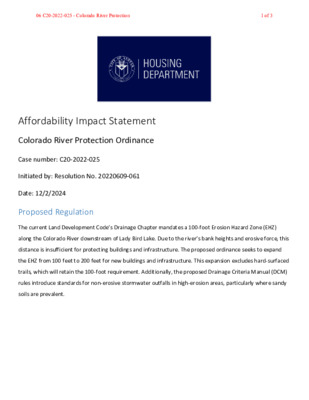06 C20-2022-025 - Colorado River Protection Affordability Impact Statement — original pdf
Backup

Affordability Impact Statement Colorado River Protection Ordinance Case number: C20-2022-025 Initiated by: Resolution No. 20220609-061 Date: 12/2/2024 Proposed Regulation The current Land Development Code’s Drainage Chapter mandates a 100-foot Erosion Hazard Zone (EHZ) along the Colorado River downstream of Lady Bird Lake. Due to the river’s bank heights and erosive force, this distance is insufficient for protecting buildings and infrastructure. The proposed ordinance seeks to expand the EHZ from 100 feet to 200 feet for new buildings and infrastructure. This expansion excludes hard-surfaced trails, which will retain the 100-foot requirement. Additionally, the proposed Drainage Criteria Manual (DCM) rules introduce standards for non-erosive stormwater outfalls in high-erosion areas, particularly where sandy soils are prevalent. 06 C20-2022-025 - Colorado River Protection1 of 3 Land Use/Zoning Impacts on Housing Costs The proposed EHZ expansion is anticipated to have a neutral impact on housing costs. Watershed Protection Department (WPD) staff have engaged with various stakeholders, including the Lower Colorado River Authority (LCRA), Travis County, Austin Water (AW), Transportation & Public Works (TPW), Parks & Recreation Department (PARD), Austin Energy (AE), community organization PODER, and developers currently undergoing permitting processes. Development stakeholders noted the 200-foot EHZ aligns with the setback under existing Critical Water Quality Zone buffers, thus minimizing development footprint impacts. Additionally, stakeholders PARD and TPW, along with developers, requested that hard-surfaced trails remain under the 100-foot requirement to prevent excessive costs, maintain the trails’ accessibility, and reduce the need for additional easement acquisitions. Impact on Development Cost The proposed changes would have minimal impacts on development cost. Financial impacts will vary by project type and whether a project is new or a redevelopment. Parcels affected by this provision are limited to those along the 25.2 miles of Colorado River downstream of Lady Bird Lake, totaling under 360 parcels. This regulation would not apply to single-family construction in the ETJ, which accounts for 70 of the 360 parcels. For new subdivisions and site plans, the impact is minimal due to the existing minimum 200-foot buffer already restricting most development. Redevelopment site plans and single-family permits, however, could face increased foundation construction costs if building within the EHZ. Structural engineers have estimated potential cost increases of 3-5 times for foundations requiring deeper subsurface anchoring and additional protections against erosion. Developers may opt to relocate structures outside the EHZ to avoid these additional costs. Although developments may increase foundation and erosion protection costs for structures in the EHZ, these costs are expected to be offset by reduced maintenance expenses. Without this ordinance, buildings constructed without protective measures would face greater risks of erosion-related damage, potentially resulting in costly public buyouts or repair expenditures. Impact on Affordable Housing The proposed changes would have a neutral impact on affordable housing. The effects on household affordability are expected to be limited due to several factors: 06 C20-2022-025 - Colorado River Protection2 of 3 1. The regulation impacts less than 360 parcels. 2. Currently, there are no multifamily residences within the proposed EHZ. Existing residential properties are predominantly single-family units with limited affordable housing potential and this regulation does not apply to single-family residential construction in the ETJ. 3. Future multifamily projects would still be required to adhere to the 200-foot setback requirement already in place, thus the new 200ft EHZ would have no more restrictive effect. In weighing the short-term costs of increased erosion protection measures against the potential long-term costs of erosion damage and buyouts, the ordinance is anticipated to preserve infrastructure and minimize future public costs. Other Policy Considerations The proposed ordinance aligns with the Watershed Protection Strategic Plan’s goals to strengthen erosion control, protect public and private assets, and maintain stable stream systems. Key objectives include preventing property damage and minimizing channel enlargement that threatens property. Austin’s Climate Equity Plan notes that “East Austin has taken on much of the burden of the city’s growth and development” and that “displacement and reduced mobility due to flooding and extreme weather are disproportionality faced by marginalized communities.” Expanding erosion protection along the Colorado River preserves the natural landscape, shields residents from environmental hazards, and supports equitable environmental stewardship, fostering long-term livability. Watershed Protection has taken a measured approach with this EHZ expansion, balancing development needs with enhanced erosion protections. This balanced approach can serve as a guiding framework for future updates to regulations in various areas, focusing on maintaining essential protections while supporting sustainable growth. Manager’s Signature ___ ___________________________________ 06 C20-2022-025 - Colorado River Protection3 of 3